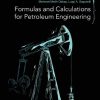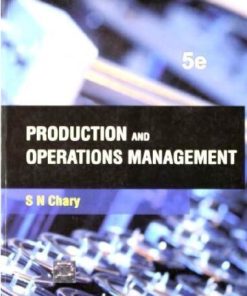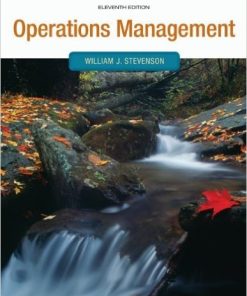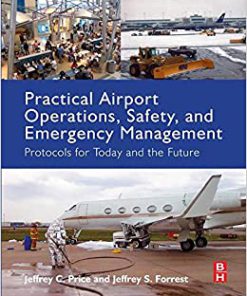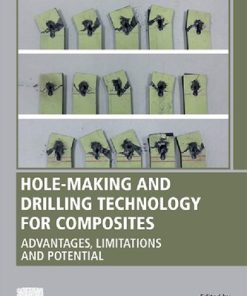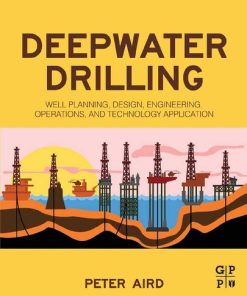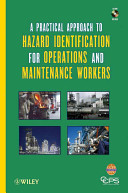(Ebook PDF) Practical wellbore hydraulics and hole cleaning unlock faster more efficient and trouble free drilling operations 1st edition by Mark Ramsey 0128170891 9780128170892 full chapters
$50.00 Original price was: $50.00.$25.00Current price is: $25.00.
Practical wellbore hydraulics and hole cleaning unlock faster, more efficient, and trouble-free drilling operations 1st edition by Mark S. Ramsey – Ebook PDF Instant Download/DeliveryISBN: 0128170891, 9780128170892
Full download Practical wellbore hydraulics and hole cleaning unlock faster, more efficient, and trouble-free drilling operations 1st edition after payment
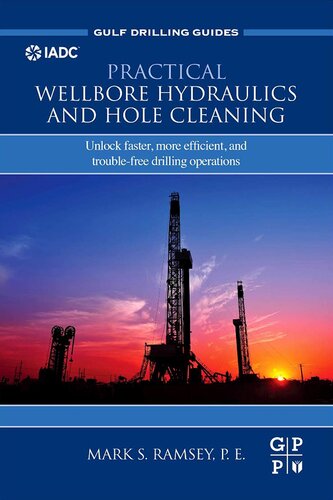
Product details:
ISBN-10 : 0128170891
ISBN-13 : 9780128170892
Author: Mark S. Ramsey
Practical Wellbore Hydraulics and Hole Cleaning presents a single resource with explanations, equations and descriptions that are important for wellbore hydraulics, including hole cleaning. Involving many moving factors and complex issues, this book provides a systematic and practical summary of solutions, thus helping engineers understand calculations, case studies and guidelines not found anywhere else. Topics such as the impact of temperature and pressure of fluid properties are covered, as are vertical and deviated-from-vertical hole cleaning differences. The importance of bit hydraulics optimization, drilling fluid challenges, pressure drop calculations, downhole properties, and pumps round out the information presented.
Practical wellbore hydraulics and hole cleaning unlock faster, more efficient, and trouble-free drilling operations 1st Table of contents:
1. Introduction
1.1 Wellbore Hydraulics
1.2 Hole Cleaning
1.3 Organization of the Book
1.4 Rate of Penetration
1.5 Pressure Losses
1.6 Rheology
1.7 Downhole Properties
1.8 Pumps
1.9 Operators, Drilling Contractors, and Service Company Partners
2. Bit Hydraulics
2.1 Introduction and Importance of Bit Hydraulics Optimization
2.1.1 Illustration of the problem
2.1.2 Organization of the chapter
2.2 Drilling Fluid Challenges Relating to Wellbore Hydraulics
2.3 Terms
2.3.1 PCIRC—circulation system pressure losses
2.3.2 Founder point
2.3.3 Hydraulic horsepower
2.3.4 Pump efficiency considerations
2.3.5 Hydraulic force (jet impact force)
2.3.6 Jet velocity
2.3.7 Flow rate
2.4 Circulating-System Pressure Losses (i.e., “Wasted Energy”)
2.4.1 Physical meaning of the exponent in the power law model: laminar, turbulent, and transitional
2.4.2 Understanding the pressure-flow rate operating window and parasitic losses
2.5 Optimum Nozzle and Flow Rate Selection
2.6 Driller’s Hydraulic Methods
2.6.1 Driller’s hydraulic method—PDC bits: Use hydraulic impact
2.6.2 Driller’s hydraulic method—tricone bits: Use hydraulic horsepower
2.7 Engineers’ Hydraulic Method—Calibrate Circulation Pressure (ΔPCIRC) to Determine Exponent
2.8 Ongoing Continuous Hydraulics Optimization Calibration Example
2.9 Optimum Conditions-Pressure Limited
2.10 Sizing the Nozzles
2.11 Pressure Recovery Downstream of the Bit Nozzles
2.11.1 A brief history of the discovery
2.11.2 Bit types
2.11.3 Viscosity effects
2.11.4 Remaining research
2.11.5 Recommended practice
2.12 Extrapolations and Corrections for Changing Conditions
2.12.1 Depth
2.12.2 Increased depth
2.12.3 Decreased depth
2.12.4 Measured depth versus true vertical depth
2.12.5 Mud weight (drilling fluid density)
2.12.6 Combined effect of measured depth and mud weight
2.12.7 Geometry (hole diameter changes)
2.12.8 Laminar pressure losses—power law model
2.12.9 Turbulent pressure losses
2.12.10 Surface equipment pressure losses
2.12.10.1 Slide rule
2.12.10.2 Approximate correlations
2.12.11 Embedded measurement with ongoing continuous hydraulics optimization
2.13 Bit “Recovery Effect,” MW, and the Bit Type Itself
2.13.1 Other drilling fluid properties
2.14 Operating Limits Changes
2.15 Pump-Off Forces
2.16 Non-optimum Conditions
2.16.1 No remaining pressure available for the bit
2.16.2 Designated flow rate (including minimum flow rate)
2.16.3 Designated nozzle sizes
2.16.4 Designated bit pressure drop
2.17 Founder Point Determination
2.17.1 “John Wayne” company man inefficiency example
2.18 Review and Energy Savings
2.19 Exercises
2.19.1 Nozzle sizing exercise
3. Hole Cleaning
3.1 Introduction
3.2 Hole-Cleaning Factors
3.3 Vertical and Deviated-From-Vertical Hole-Cleaning Differences
3.4 Vertical Well Intervals
3.4.1 Robinson’s Cuttings Carrying Index
3.4.2 “Cuttings block” effect
3.4.3 Sifferman’s transport ratio
3.4.4 Robinson and Sifferman comparison
3.4.5 Summary (vertical intervals)
3.5 High-Angle Hole Cleaning
3.5.1 Boycott settling: the crux of the problem
3.5.2 Rules of thumb—guidelines
3.6 Trend Analysis in High-Angle Wellbores
3.6.1 Cuttings bed measurement and management
3.7 Horizontal Well Hydraulics
3.8 Instructive Video
3.9 Chapter Appendices
3.9.1 Blank K (plastic viscosity, yield point) chart (for use in problems)
3.9.2 Exercise with Cuttings Carrying Index
3.9.3 Slip velocities
3.9.4 Velocity profiles (cuttings movement)
3.9.5 Viscoelasticity, elastic modulus, viscous modulus
3.9.6 Barite sag
3.9.7 Back-reaming
3.9.8 Sweeps
3.9.9 Turbulizers/spiral centralizers
4. Effects on Drilling Efficiency and Rate of Penetration
4.1 Introduction
4.2 Theoretical Considerations
4.2.1 Kinematic and absolute viscosity effects
4.2.2 Solids content and plastic viscosity
4.2.3 API fluid loss
4.2.4 Dynamic filtration loss (aka “spurt loss”)
4.3 Practical Considerations
4.3.1 Drill-off tests
4.3.1.1 Conventional drill-off tests
4.3.1.2 Expedited drill-off tests
4.3.1.3 Automated
4.3.2 Recommended practices
4.4 Hydraulic Erosion of the Wellbore
4.4.1 Historical
4.4.2 Measurements of borehole diameters
4.4.2.1 Fluid caliper
4.4.2.2 Measurement while drilling/Logging while drilling
4.4.2.3 Wireline
4.4.3 Perceived hydraulic hole enlargement cause
4.4.4 Objections
4.4.5 Explanations for hole enlargements
4.5 Drill Pipe Size Effects
4.6 Rock Failure
4.6.1 Rock and bit tooth/rock interaction
4.6.2 Variables that affect drilling rate
4.6.3 Drilling rate equation
4.6.4 Effect of rotary speed on drilling rate
4.6.5 Effect of differential pressure
4.6.6 Effect of weight on bit on drilling rate
4.7 Founder Points
4.7.1 Exercises to determine the founder point using drill-off data
4.8 Effect of Hydraulics
4.9 Drill-Off Tests
4.9.1 Drill-off procedure
4.9.2 Computer-assisted drill-off tests
4.9.3 Drill-off problem
4.10 d-Exponent
4.11 Corrected d-Exponent (dc)
4.11.1 Exercises
4.11.2 Corrected d-exponent example
4.11.3 DP stretch drill-off test exercise
4.12 Mechanical Specific Energy
4.13 Additional References
5. Pressure Drop Calculations
5.1 Introduction
5.2 Concepts
5.3 Surface and Bottom-Hole Pressures
5.3.1 Hydrostatic pressure
5.3.2 Dual-gradient systems
5.4 Flow Regimes
5.4.1 Laminar, turbulent, transitional flow
5.4.2 Newtonian
5.4.3 Non-Newtonian
5.4.4 More on transitional flow and pressure losses
5.4.5 Reconciliation and recommendations
5.5 Friction Factors
5.5.1 Brief history
5.5.2 Friction factor approximations
5.5.3 Pressure loss calculations in wellbores
5.5.3.1 Pipe
5.5.3.2 Annulus
5.5.3.3 Eccentric annulus
5.5.4 Wellbore hydraulics design and operational considerations
5.6 Casing Drilling
5.6.1 Underreamers
5.7 Coiled Tubing Opportunity
5.8 Bit Nozzles
5.9 Other Geometry Effects Such as Centralizers, Reamers, Pipe Joints, Hole Rugosity, etc.
5.10 Equivalent Circulating Density Calculation
5.11 Surge and Swab Pressures
5.11.1 Trapped pressures
5.11.2 Combined effects are more than additive
5.11.3 Deepwater—supercharging, flowback, and fingerprinting
5.12 Hole Washouts
5.13 Riser Boost
5.14 Cuttings Bed Effect
5.15 Dual-Gradient Systems
5.15.1 Discussion
5.15.2 Illustrative exercise—dual gradient
5.15.3 Pressurized mud cap
5.15.4 Dual mud weight system
5.15.5 Mud line pumping system
5.15.6 Suspended “riserless” pump system
5.15.7 Mud line “riserless” pump system
5.16 Coiled Tubing Drilling
5.17 Exercises
6. Rheology, Viscosity, and Fluid Types
6.1 Rheology
6.2 Viscosity
6.3 Rotary Viscometer
6.4 Laminar, Turbulent, and Transitional Flow
6.4.1 Laminar flow
6.4.2 Turbulent flow
6.4.3 Transitional flow
6.4.4 Reynolds number
6.5 Bingham Plastic Flow
6.6 Power Law and Herschel–Bulkley Fluids
6.6.1 Simple power law
6.6.2 Power law with yield stress (Herschel–Bulkley)
6.7 Gel Strength
6.8 Temperature and Pressure Effects
6.9 Thixotropic Fluids
6.10 Other Topics
7. Downhole Properties
7.1 Introduction
7.2 Measurement Locations
7.3 Temperature Effects
7.4 Mud Line Temperature Offshore
7.5 Dynamic or Transient Effects
7.6 Pressure Effects
7.7 Annular Cuttings Load Effect on Density
7.8 Contamination Effects
7.9 Salt Effects on Oil and Synthetic Fluid-Based Mud Systems
7.9.1 Background
7.9.2 Balanced activity oil-based muds
7.9.3 Excess salt oil-based muds
7.10 Time Effects
7.11 Other Effects on Downhole Properties
7.12 Summary
8. Pumps
8.1 Introduction
8.2 Classification of Pumps
8.3 Kinetic
8.3.1 Centrifugal pumps
8.3.2 Turbine pumps
8.4 Positive Displacement Pumps
8.4.1 Progressive cavity
8.4.2 Triplex
8.4.3 Duplex/double-acting
8.4.4 Hex pumps (six vertical cylinders)
8.5 Efficiencies
9. Appendix
9.1 Reynolds Number Conversion Factor for US Oilfield Units
9.2 Reynolds Number Form with US Oilfield Units for Annulus
9.3 Reynolds Number Form With US Oilfield Units for Inside Pipe
9.4 Gallons Per Minute to Average Velocity for a Pipe or Annulus
9.5 Turbulent Flow Pipe Pressure Loss From Fanning Friction Factor Definition
9.5.1 Fanning diagram
9.5.2 Moody diagram
9.6 Hydraulic Diameter Derivation
9.7 Derivation of the Effective Viscosity Term “K”
9.8 Boycott Settling
9.9 Derivation of Optimum ΔPBIT and ΔPCIRC
9.9.1 Derivation of maximum hydraulic jet impact force at the bit
9.9.1.1 Derivation of the optimum jet impact force for the surface pressure limit condition (API’s
9.9.1.2 Derivation of the optimum jet impact force for the power limited condition (API’s Region 3
9.9.2 Derivation of equation for maximum hydraulic horsepower at bit
9.9.2.1 Discussion of the optimum hydraulic horsepower for the maximum pressure limited condition (A
9.9.2.2 Discussion of the optimum hydraulic horsepower for the power limited condition (API’s Regi
9.10 Nozzle Tables and Charts
People also search for Practical wellbore hydraulics and hole cleaning unlock faster, more efficient, and trouble-free drilling operations 1st:
hydraulic works on which principle
what is wellbore stability
hydraulic jack not holding pressure
practical hydraulic systems pdf
hydraulic well
Tags:
Practical,hydraulics,hole cleaning,faster,efficient,Mark Ramsey
You may also like…
Engineering - Mechanical Engineering & Dynamics
Uncategorized
Practical Airport Operations, Safety, and Emergency Management: Protocols for Today and the Future
Housekeeping & Leisure - Interior Design & Decoration
Housekeeping & Leisure - Gardening


